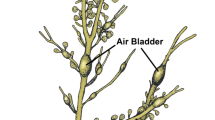Abstract
Many species of cyanophytes, especially those growing on tiles and walls exposed to air and sunlight, appear black due to the presence of pigments in the mucilaginous cell-walls. Such pigments may serve a protective role against adverse effects of ultraviolet light but, overlying the ordinary intracellular blue-green pigments, they make the algal clumps look black. Among the most familiar of such algae are species of Gloeocapsa, which by discolouring pale surfaces of public or private premises can constitute a nuisance responsible for a considerable loss of financial value.
Similar content being viewed by others
References
Abdelahad N, Bazzichelli G (1991) The genus Gloeocapsa Kuetz. (Cyanophyta) on calcareous rock surfaces in the upper valley of the river Aniene (Latium, Italy). Crypt. Bot. 2/3: 155–160.
Dai J (1992) (Review of the research of Nostoc flagelliforme) J. Ningxia Univ. 13: 71–77. (In Chinese; quoted by Gao and Ye, 2003).
Gao K, Ye C (2003) Culture of the terrestrial cyanobacterium, Nostoc flagelliforme (Cyanophyceae), under aquatic conditions. J. Phycol. 38: 617–623.
Garcia-Pichel F, Castenholz RW (1993) Occurrence of UV-absorbing mycosporine-like compounds among cyanoacterial isolates, and an estimate of their screening capacity. Applied Environmental Microbiology 59: 163–169.
Garcia-Pichel F, Sherry ND, Castenholtz RW (1992) Evidence for an ultraviolet sunscreen role of the extracellular pigment scytonemin in the terrestrial cyanobacterium Chlorogloeopsissp. Photochem. Photobiol. 56: 17–23.
Jaag O (1945) Die Gattung Gloeocapsa. Untersuchungen ueber die Vegetation und Biologie der Algen des nackten Gesteins in den Alpen, im Jura und im schweizerischen Mittelland. Schweizerischen Naturforschenden Gesellschaft 9: 180–221.
Komarek J (1991) Gloeocapsa Kuetzing 1843, in Suesserflora von Mitteleuropa, Jena. Cyanoprokaryota 1: Chroococcales 236–261.
Lee RE Phycology (2nd edn., Cambridge University Press) Ecology of blue-green algae: Marine environment: Littoral zone, pp. 77–81.
Proteau PJ, Gerwick WH, Garcia-Pichel F, Castenholz R (1993) The structure of scytonemin, an ultraviolet sunscreen pigment from the sheaths of cyanobacteria. Experientia 49: 825–829.
Rippka R, Desruelles J, Waterbury JB, Herdman M, Stanier RY (1979) Generic assignments, strain histories and properties of pure cultures of Cyanobacteria. J. gen. Microbiol. 111: 1–61.
Sheath RG, Vis ML, Hambrook JA, and Cole KM (1996) Tundra stream macro-algae of North America: Composition, distribution and physiological adaptations. Hydrobiologia. 336: 67–82.
Skuja H (1949) Gloeocapsa, in Zur Suesswasseralgenflora Burmas. Nova Acta Regiae Soc. Scient. Upsaliensis IV 14: 16–18.
Wee YC, Lee KB (1980) Proliferation of algae on surfaces of buildings in Singapore. Int. Biodeterioration Bull. (ISSN 0020-6164) 16: 113–117.
Zehnder A (1960) Zur Systematik der Chroococcaceae Schweitz. Z. Hydrobiol. 22: 365–375.
Author information
Authors and Affiliations
Corresponding author
Rights and permissions
About this article
Cite this article
Lewin, R.A. Black algae. J Appl Phycol 18, 699–702 (2006). https://doi.org/10.1007/s10811-005-9018-2
Received:
Accepted:
Published:
Issue Date:
DOI: https://doi.org/10.1007/s10811-005-9018-2




